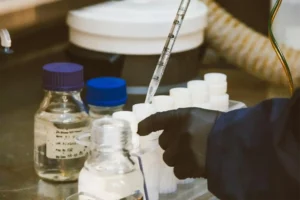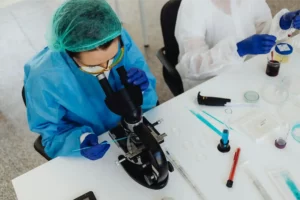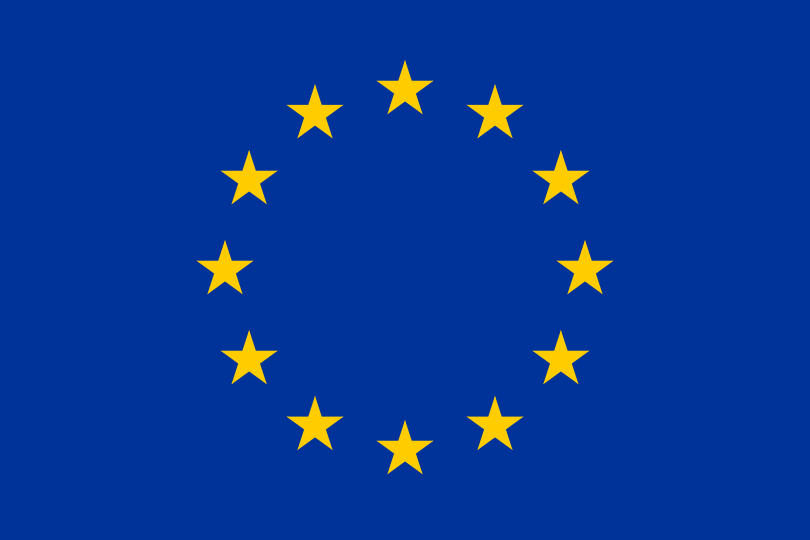In pharmaceutical development, ensuring that products consistently meet predefined standards of identity, strength, purity, and quality it’s essential. As drug candidates move from early research through commercial production, robust pharma quality control strategies become the backbone of safe, effective, and regulatory-compliant medicines. The integration of these quality systems, aligned with global regulatory frameworks, supports both the scientific rigor and the operational integrity of a successful drug development strategy.
Processes in Pharma Quality Control: From Raw Materials to Final Product
The quality control process in the pharmaceutical industry is a systematic, multi-stage approach that ensures each step in the drug production pipeline meets exacting standards. From sourcing raw materials to the release of the finished product, every element is tested, validated, and monitored.

Key stages include:
- Raw material testing
Ensures that all inputs meet defined specifications before use. This involves performing analytical tests, such as high- or ultra-high-performance liquid chromatography (HPLC, UPLC) and mass spectrometry (MS), to assess purity, identity, and potential contaminants. Physicochemical and microbiological properties are also evaluated when relevant. Early-stage analytical support helps maintain consistency and reliability in downstream development.
- In-process quality control (IPQC)
It consists of monitoring critical process parameters in pharmaceuticals (e.g., temperature, pH, mixing speed) to detect deviations during manufacturing. These controls maintain batch consistency and minimize the risk of reprocessing. Real-time data, validated methods, and bioanalytical testing, when needed, strengthen process reliability.
- Finished product testing
It is conducted on every batch before release, verifying that the drug meets specifications for identity, strength, purity, and performance. Common assessments include content uniformity, dissolution profiles, sterility, and impurity profiling, using advanced methods like UPLC-MS/MS and elemental analysis. Capabilities in method transfer, validation, and stability testing ensure audit readiness.
- Stability testing
It examines how a drug’s quality evolves under various environmental conditions. This ensures safety and efficacy across the product’s shelf life. Long-term and accelerated studies, conducted under the International Council for Harmonisation of Technical Requirements for Pharmaceuticals for Human Use (ICH) guidelines, require robust analytical follow-up. Controlled storage, time-point analysis, and biomarker tracking are essential tools for regulatory support.
This framework forms the operational core of any quality control department in the pharma industry, playing a vital role in safeguarding product integrity and patient safety.
Quality Control and Regulatory Compliance: Meeting Global Standards
Regulatory compliance in pharma is governed by international guidelines and agencies like the US Food and Drug Administration (FDA), European Medicines Agency (EMA), and ICH, which define the expectations for quality, safety, and efficacy. To meet these expectations, companies must implement robust quality control strategies in drug development that align with Good Manufacturing Practice (GMP compliance) and other regulatory requirements, such as those stated in Title 21 of the FDA Code of Federal Regulations (CFR).

To meet these global standards, companies should:
- Stay informed of regulatory updates
- Implement a robust Quality Management System (QMS)
- Conduct regular audits and inspections
- Maintain thorough documentation
- Foster a culture of compliance
By prioritizing quality control and regulatory compliance, businesses can successfully navigate the complexities of global markets, ensuring they deliver high-quality products and services while operating responsibly and ethically.
Quality Risk Management and Analytical Method Validation
Quality risk management in pharma is a proactive approach to identifying, assessing, and mitigating risks throughout the manufacturing and quality control process. It is an integral part of a modern pharmaceutical quality system and is emphasized in ICH Q9 and Q10 guidelines.
Key aspects include:
- Risk assessment: Systematically evaluating potential sources of variability or failure in processes, equipment, and materials.
- Risk control: Implementing measures to minimize or eliminate identified risks.
- Risk review: Continuously monitoring and updating risk assessments as new information or technologies become available.
Analytical method validation in pharma is crucial to demonstrate that test methods are reliable and reproducible for their intended use. Parameters typically validated include:
- Accuracy and precision: Methods must produce results that are both correct and consistent.
- Specificity and sensitivity: Ability to detect the target analyte without interference.
- Robustness: Consistent performance under varying conditions.
Validated methods are essential for regulatory submissions and are required for all critical quality attributes tested during the quality control process in the pharmaceutical industry. In this context, partnering with experts in method development, validation, and transfer, particularly when working with sensitive techniques like LC-MS/MS, UPLC, or biomarker quantification, can significantly strengthen both compliance and data reliability.
Integrating Quality Control Strategies in Early Drug Development
Integrating quality control strategies in drug development from the earliest stages is vital for building quality into the product, rather than relying on end-stage testing alone. The Quality by Design (QbD) approach, as outlined in ICH Q8, advocates for a science- and risk-based framework that emphasizes understanding the product and process from the outset. This approach is especially relevant in biopharmaceutical development, where tailored analytical and regulatory solutions are needed to address product complexity and ensure compliance.

Early integration includes:
- Defining critical quality attributes (CQAs)
- Establishing critical process parameters
- Developing validated analytical methods using UPLC-MS/MS, ICP-MS, and other advanced tools
- Implementing Process Analytical Technology (PAT) for real-time monitoring
Early quality planning also enables alignment with pharma regulatory strategy objectives, helping streamline Investigational New Drugs (IND) and New Drug Application (NDA) submissions and reducing the likelihood of costly delays due to data gaps or compliance issues.
Achieving excellence in pharma quality control and regulatory compliance requires expertise, advanced analytical capabilities, and a proactive approach to risk and process management. At AMSbiopharma, we support pharmaceutical innovators with comprehensive quality control solutions, from analytical method development and validation to regulatory strategy and risk management.
Discover how we can support your quality control strategy!
References
Pharma Now. Quality Control in Pharmaceutical Manufacturing [Internet]. 2025 [cited 2025 Jul 4]. Available from: https://www.pharmanow.live/pharma-manufacturing/quality-control-in-pharmaceutical-manufacturing
Food and Drug Administration. Current Good Manufacturing Practice (CGMP) Regulations [Internet]. Silver Spring (MD): U.S. Food and Drug Administration; [cited 2025 Jul 4]. Available from: https://www.fda.gov/drugs/pharmaceutical-quality-resources/current-good-manufacturing-practice-cgmp-regulations
International Council for Harmonisation of Technical Requirements for Pharmaceuticals for Human Use (ICH). Quality Guidelines [Internet]. Geneva: ICH; [cited 2025 Jul 4]. Available from: https://www.ich.org/page/quality-guidelines
World Health Organization. Quality control guidelines. [Internet]. Geneva: WHO; 2025 Apr 15 [cited 2025 Jul 4]. Available from: https://www.who.int/teams/health-product-and-policy-standards/standards-and-specifications/norms-and-standards-for-pharmaceuticals/guidelines/quality-control
World Health Organization. WHO technical report series, No. 981, Annex 2: WHO guidelines on quality risk management [Internet]. Geneva: WHO; [cited 2025 Jul 4]. Available from: https://www.who.int/publications/m/item/trs981-annex2
Sudheeshna M, Malarvannan M, Vinod Kumar K, Kranthi Kumar B. Perspectives on analytical method validation strategies and importance in pharmaceutical research. World Journal of Pharmaceutical Research. 2022;11(13):134-146. doi:10.20959/wjpr202213-25684
Agencia Española de Medicamentos y Productos Sanitarios (AEMPS). Guía de normas de correcta fabricación de la Unión Europea para medicamentos de uso humano y veterinario [Internet]. Madrid: AEMPS; 2023 May 11 [cited 2025 Jul 4]. Available from: https://www.aemps.gob.es/industria-farmaceutica/guia-de-normas-de-correcta-fabricacion/


